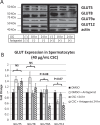Modeling the effect of cigarette smoke on hexose utilization in spermatocytes
- PMID: 24803506
- PMCID: PMC4527419
- DOI: 10.1177/1933719114533727
Modeling the effect of cigarette smoke on hexose utilization in spermatocytes
Abstract
We set out to determine whether the addition of an aryl hydrocarbon receptor (AHR) antagonist has an effect on glucose/fructose utilization in the spermatocyte when exposed to cigarette smoke condensate (CSC). We exposed male germ cells to 5 and 40 μg/mL of CSC ± 10 μmol/L of AHR antagonist at various time points. Immunoblot expression of specific glucose/fructose transporters was compared to control. Radiolabeled uptake of 2-deoxyglucose (2-DG) and fructose was also performed. Spermatocytes utilized fructose nearly 50-fold more than 2-DG. Uptake of 2-DG decreased after CSC + AHR antagonist exposure. Glucose transporters (GLUTs) 9a and 12 declined after CSC + AHR antagonist exposure. Synergy between CSC and the AHR antagonist in spermatocytes may disrupt the metabolic profile in vitro. Toxic exposures alter energy homeostasis in early stages of male germ cell development, which could contribute to later effects explaining decreases in sperm motility in smokers.
Keywords: GLUT12; GLUT9a; cigarette smoke; fructose; spermatocytes.
© The Author(s) 2014.
Conflict of interest statement
Figures




Similar articles
-
Modulation of cell cycle progression in the spermatocyte cell line [GC-2spd(ts) Cell-Line] by cigarette smoke condensate (CSC) via arylhydrocarbon receptor-nuclear factor erythroid 2-related factor 2 (Ahr-Nrf2) pathway.Biol Reprod. 2014 Jan 16;90(1):9. doi: 10.1095/biolreprod.113.113225. Print 2014 Jan. Biol Reprod. 2014. PMID: 24258214
-
Cigarette smoke-induced cell cycle arrest in spermatocytes [GC-2spd(ts)] is mediated through crosstalk between Ahr-Nrf2 pathway and MAPK signaling.J Mol Cell Biol. 2015 Feb;7(1):73-87. doi: 10.1093/jmcb/mju049. Epub 2014 Dec 29. J Mol Cell Biol. 2015. PMID: 25548370
-
Cigarette smoke condensate induces aryl hydrocarbon receptor-dependent changes in gene expression in spermatocytes.Reprod Toxicol. 2012 Dec;34(4):665-76. doi: 10.1016/j.reprotox.2012.10.005. Epub 2012 Oct 13. Reprod Toxicol. 2012. PMID: 23069111
-
Smoking-induced aggravation of experimental arthritis is dependent of aryl hydrocarbon receptor activation in Th17 cells.Arthritis Res Ther. 2018 Jun 8;20(1):119. doi: 10.1186/s13075-018-1609-9. Arthritis Res Ther. 2018. PMID: 29884199 Free PMC article.
-
Paternal smoking and germ cell death: A mechanistic link to the effects of cigarette smoke on spermatogenesis and possible long-term sequelae in offspring.Mol Cell Endocrinol. 2016 Nov 5;435:85-93. doi: 10.1016/j.mce.2016.07.015. Epub 2016 Jul 14. Mol Cell Endocrinol. 2016. PMID: 27424142 Free PMC article. Review.
Cited by
-
Trehalose inhibits solute carrier 2A (SLC2A) proteins to induce autophagy and prevent hepatic steatosis.Sci Signal. 2016 Feb 23;9(416):ra21. doi: 10.1126/scisignal.aac5472. Sci Signal. 2016. PMID: 26905426 Free PMC article.
-
Maternal fructose drives placental uric acid production leading to adverse fetal outcomes.Sci Rep. 2016 Apr 29;6:25091. doi: 10.1038/srep25091. Sci Rep. 2016. PMID: 27125896 Free PMC article.
-
The Aryl Hydrocarbon Receptor Relays Metabolic Signals to Promote Cellular Regeneration.Stem Cells Int. 2016;2016:4389802. doi: 10.1155/2016/4389802. Epub 2016 Aug 3. Stem Cells Int. 2016. PMID: 27563312 Free PMC article. Review.
References
-
- Ding YS, Ashley DL, Watson CH. Determination of 10 carcinogenic polycyclic aromatic hydrocarbons in mainstream cigarette smoke. J Agric Food Chem. 2007;55 (15):5966–5973. - PubMed
-
- Georgellis A, Montelius J, Rydstrom J. Evidence for a free-radical-dependent metabolism of 7,12-dimethylbenz(a)anthracene in rat testis. Toxicol Appl Pharmacol. 1987;87 (1):141–154. - PubMed
-
- Schultz R, Suominen J, Varre T, et al. Expression of aryl hydrocarbon receptor and aryl hydrocarbon receptor nuclear translocator messenger ribonucleic acids and proteins in rat and human testis. Endocrinology. 2003;144 (3):767–776. - PubMed
-
- Georgellis A, Toppari J, Veromaa T, Rydstrom J, Parvinen M. Inhibition of meiotic divisions of rat spermatocytes in vitro by polycyclic aromatic hydrocarbons. Mutat Res. 1990;231 (2):125–135. - PubMed
-
- Esakky P, Hansen DA, Drury AM, Moley KH. Cigarette smoke condensate induces aryl hydrocarbon receptor-dependent changes in gene expression in spermatocytes. Reprod Toxicol. 2012;34 (4):665–676. - PubMed
Publication types
MeSH terms
Substances
Grants and funding
LinkOut - more resources
Full Text Sources
Other Literature Sources

